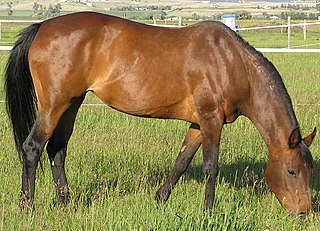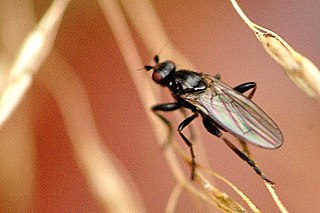
The white-winged tern, or white-winged black tern, is a species of tern in the family Laridae. It is a small species generally found in or near bodies of fresh water across much of the world, including Europe, Africa, Asia, and Australia. The genus name is from Ancient Greek khelidonios, "swallow-like", from khelidon, "swallow".

Bay is a hair coat color of horses, characterized by a reddish-brown or brown body color with a black point coloration of the mane, tail, ear edges, and lower legs. Bay is one of the most common coat colors in many horse breeds.

The Goliath birdeater belongs to the tarantula family Theraphosidae. Found in northern South America, it is the largest spider in the world by mass – 175 g (6.2 oz) – and body length – up to 13 cm (5.1 in) – but it is second to the giant huntsman spider by leg span. It is also called the Goliath bird-eating spider; the practice of calling theraphosids "bird-eating" derives from an early 18th-century copper engraving by Maria Sibylla Merian that shows one eating a hummingbird. Despite the spider's name, it rarely preys on birds.

Cerapteryx graminis, the antler moth, is a moth of the family Noctuidae. It is a common species throughout most of Europe but is lacking in the very dry southern regions. The northernmost occurrence is Iceland, and above the Arctic circle. It also occurs in Siberia and in North Mongolia. The species has been introduced to North America. In the Alps it rises to an altitude of 2100 meters.

Sphaeroceridae are a family of true flies in the order Diptera, often called small dung flies, lesser dung flies or lesser corpse flies due to their saprophagous habits. They belong to the typical fly suborder Brachycera as can be seen by their short antennae, and more precisely they are members of the section Schizophora. There are over 1,300 species and about 125 genera accepted as valid today, but new taxa are still being described.

The common eastern froglet is a very common, Australian ground-dwelling frog, of the family Myobatrachidae.

The Heleomyzidae is a small family of true flies in the insect order Diptera. Over 740 described species of Heleomyzidae occur in about 76 genera distributed throughout the world.

The Angolan genet or miombo genet is a genet species endemic to Southern Africa. It is considered common in this region and therefore listed as Least Concern in the IUCN Red List. Little is known about its ecology.

The Splendid astrapia is a species of Astrapia of the birds-of-paradise family, Paradisaeidae, and one of the least known and most elusive of its family and genus.

The Moluccan megapode, also known as Wallace's scrubfowl, Moluccan scrubfowl or painted megapode, is a small, approximately 31 cm long, olive-brown megapode. The genus Eulipoa is monotypic, but the Moluccan megapode is sometimes placed in Megapodius instead. Both sexes are similar with an olive-brown plumage, bluish-grey below, white undertail coverts, brown iris, bare pink facial skin, bluish-yellow bill and dark olive legs. There are light grey stripes on reddish-maroon feathers on its back. The young has brownish plumage, a black bill, legs and hazel iris.

Hemaris thysbe, the hummingbird clearwing, is a moth of the family Sphingidae (hawkmoths). Coloration varies between individuals, but typically the moth is olive green and burgundy on its back, and white or yellow and burgundy on the underside. Its wings are transparent with a reddish-brown border. It has light-colored legs, which combined with the lack of striping on the underside is diagnostic. Beating its wings rapidly, H. thysbe hovers to collect nectar from a variety of flowers. The combination of its appearance and its behavior commonly leads to it being confused with a hummingbird or bumblebee.

The chimango caracara is a species of bird of prey in the family Falconidae. It is found in Argentina, Uruguay, Chile, Paraguay and south of Brazil. The chimango is found as far south as Tierra del Fuego and is a vagrant to the Falkland Islands.

Opilio canestrinii is a species of harvestman.

Carcinosoma is a genus of eurypterid, an extinct group of aquatic arthropods. Fossils of Carcinosoma are restricted to deposits of late Silurian age. Classified as part of the family Carcinosomatidae, which the genus lends its name to, Carcinosoma contains seven species from North America and Great Britain.
Poecilosomella is a genus of flies belonging to the family Lesser Dung flies. These small flies, often with attractive patterning on the wings and body, are commonly found in a wide range of habitats throughout the Old World and Australasia.
Poecilosomella brevisecunda is a species of fly belonging to the family Sphaeroceridae. It has only been recorded from Gunung Leuser National Park in northern Sumatra, Indonesia.
Poecilosomella conspicua is a distinctive species of flies belonging to the family Sphaeroceridae. It is only known from the Crocker Range, Sabah in northern Borneo.

Anticlea derivata, the streamer, is a moth of the family Geometridae. The species was first described by Michael Denis and Ignaz Schiffermüller in 1775. It is found in Europe, North Africa and across the Palearctic up to the Altai Mountains.It prefers to live on sunny slopes, hedge rows, bushy places as well as in gardens and parks.

Limosininae is a subfamily of flies belonging to the family Sphaeroceridae, the lesser dung flies.
Poecilosomella angulata is a species of lesser dung flies.















